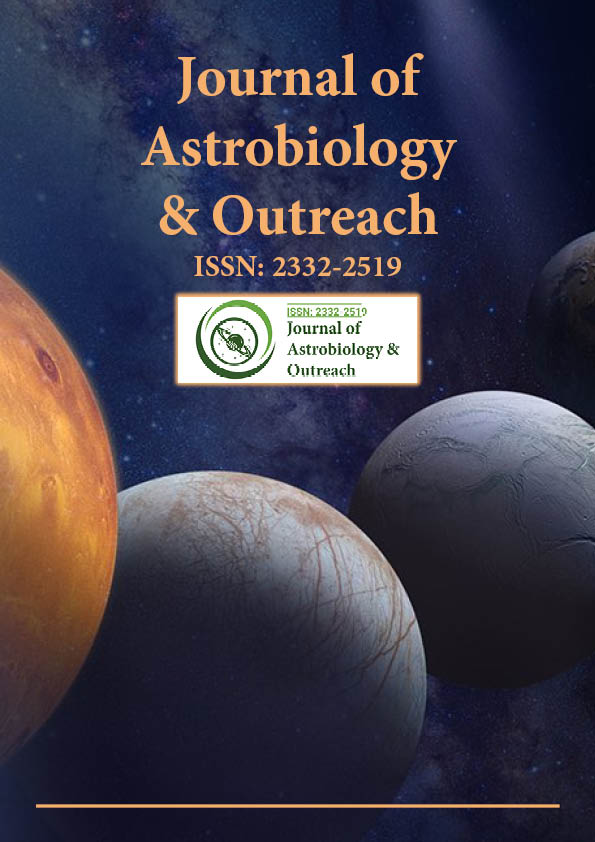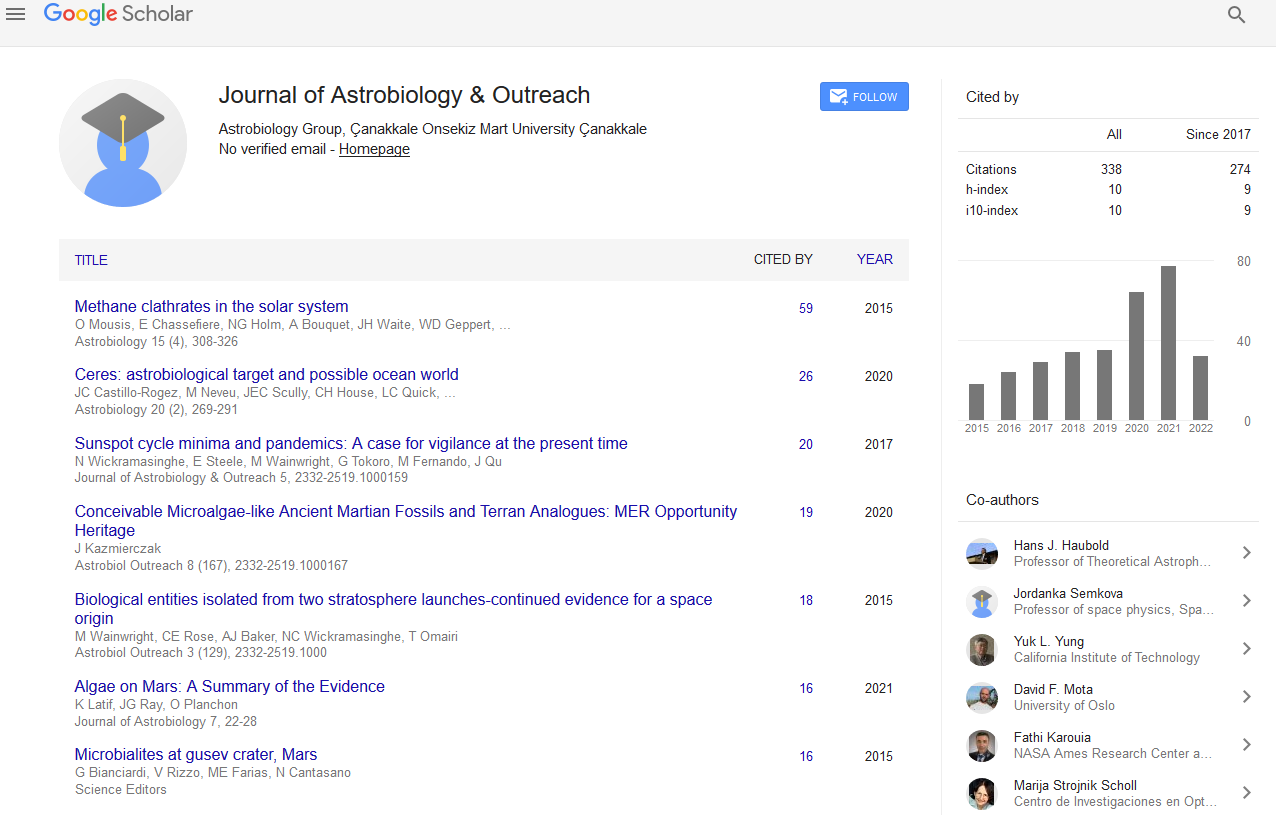Indexed In
- Open J Gate
- Academic Keys
- JournalTOCs
- RefSeek
- Hamdard University
- EBSCO A-Z
- OCLC- WorldCat
- Google Scholar
Useful Links
Share This Page
Journal Flyer

Open Access Journals
- Agri and Aquaculture
- Biochemistry
- Bioinformatics & Systems Biology
- Business & Management
- Chemistry
- Clinical Sciences
- Engineering
- Food & Nutrition
- General Science
- Genetics & Molecular Biology
- Immunology & Microbiology
- Medical Sciences
- Neuroscience & Psychology
- Nursing & Health Care
- Pharmaceutical Sciences
Commentary - (2023) Volume 11, Issue 5
Impact of Gravitational Wave Astronomy and Astrophysics
Paolo Pani*Received: 22-Aug-2023, Manuscript No. JAO-23-24786; Editor assigned: 25-Aug-2023, Pre QC No. JAO-23-24786(PQ); Reviewed: 08-Sep-2023, QC No. JAO-23-24786; Revised: 15-Sep-2023, Manuscript No. JAO-23-24786(R); Published: 25-Sep-2023, DOI: 10.35248/2332-2519.23.11.320
Description
In the vast cosmic tapestry of the universe, where celestial bodies starts a gravitational forces, a spectacular event unfolds: the coalescence of massive binary black holes. This cosmic ballet, driven by the relentless tug of gravity, is a phenomenon that captivates astronomers and astrophysicists alike.
Before delving into the coalescence, it's important to understand the genesis of binary black holes. These stellar behemoths are born from the explosive deaths of massive stars. As a massive star exhausts its nuclear fuel, it undergoes a supernova, collapsing under its gravitational self-attraction. The remnants can give rise to a black hole, an object so dense that not even light can escape its gravitational pull.
In some cosmic scenarios, two such black holes find themselves in orbit around each other, forming a binary system. This binary dance is initiated during the tumultuous death throes of massive stars or through subsequent gravitational interactions in dense stellar environments.
Once formed, the binary black hole system begins a complex dance dictated by the laws of gravity. Emitting gravitational waves, a phenomenon predicted by Albert Einstein's general theory of relativity, the binary black holes gradually lose energy and angular momentum. This loss results in a slow inward spiral of the black holes toward each other.
As the binary system's orbit decays, the black holes approach ever closer, locked in a gravitational embrace. The process leading up to coalescence is a complex interplay of orbital dynamics, energy loss through gravitational wave emission, and the inexorable pull of gravity.
The crescendo of this cosmic ballet is the emission of gravitational waves ripples in the fabric of spacetime itself. These waves, predicted by Einstein a century ago, carry away energy from the binary system, causing the black holes to lose orbital energy and spiral closer together.
The emitted gravitational waves are incredibly faint, requiring sensitive instruments to detect them. Innovative observatories like LIGO and Virgo have achieved this feat, will bring in a new era of gravitational wave astronomy. The detection of these waves not only confirms the existence of binary black hole systems but also provides a unique tool to explore the universe in a fundamentally different way.
As the binary black holes draw near, the gravitational waves intensify, heralding the final act of their cosmic dance the coalescence. The black holes, once distinct entities, merge into a single, more massive black hole. This violent union releases an extraordinary amount of energy in the form of gravitational waves, creating ripples that propagate across the universe.
The merger process is a culmination of extreme astrophysical conditions, involving gravitational forces so intense that they warp the fabric of spacetime. The resulting black hole exhibits properties shaped by the masses and spins of its progenitors, providing a unique signature that astronomers can study.
The innovative success of the Laser Interferometer Gravitational-Wave Observatory (LIGO) and the Virgo Observatory has opened a new chapter in astrophysics. These observatories, equipped with sophisticated interferometers, have enabled the direct detection of gravitational waves from mass binary black hole coalescence.
LIGO, with facilities in the United States, and Virgo, located in Italy, work in tandem to triangulate the source of gravitational waves. The collaboration has resulted in multiple detections, unveiling a population of binary black hole systems across the cosmos. Each detection provides a unique snapshot of the universe's dynamic and often-violent processes.
The detections of mass binary black hole coalescence offer valuable insights into the population and formation mechanisms of black holes. The observed mergers suggest the existence of binary black hole systems in various cosmic environments, from isolated stellar regions to dense galactic clusters.
Moreover, the masses of the merging black holes provide important information about their origins. The LIGO and Virgo collaborations have observed black holes with masses ranging from a few times that of the sun to over a hundred solar masses. These findings challenge previous assumptions about the maximum mass a stellar black hole can attain through stellar evolution.
The study of mass binary black hole coalescence not only enhances our understanding of black hole populations but also serves as a laboratory for testing fundamental physics. Gravitational wave observations provide a direct confirmation of Einstein's theory of general relativity in the strong-field regime, where gravitational forces are extremely intense.
Additionally, the observed merger rates and properties contribute to our understanding of astrophysical processes, such as star formation, stellar evolution, and the dynamics of dense stellar environments. The discoveries made through gravitational wave astronomy represent a convergence of theoretical predictions, observational capabilities, and technological innovation.
As gravitational wave astronomy continues to evolve, with new observatories on the horizon, the study of mass binary black hole coalescence is poised to reach new heights. Future detectors, including the LIGO-India collaboration and the space-based Laser Interferometer Space Antenna (LISA), hold the potential of expanding our observational capabilities.
LISA, designed for space-based observations, will explore lowerfrequency gravitational waves, offering a unique perspective on a broader range of astrophysical phenomena, including massive black hole mergers in the centers of galaxies.
In the grand cosmic ballet of the universe, mass binary black hole coalescence stands out as a mesmerizing and scientifically rich spectacle. The detection of gravitational waves from these events has ushered in a new era of astrophysics, providing unprecedented insights into the dynamics of black holes and the nature of gravity itself.
As our observational tools advance and new technologies come into play, the cosmic dance of black hole mergers will continue to unveil mysteries, challenge existing theories, and contribute to our ever-growing understanding of the vast and dynamic cosmos. The study of mass binary black hole coalescence represents not only a triumph for gravitational wave astronomy but also a testament to humanity's relentless pursuit of knowledge about the fundamental workings of the universe.
Citation: Pani P (2023) Impact of Gravitational Wave Astronomy and Astrophysics. J Astrobiol Outreach. 11:320.
Copyright: © 2023 Pani P. This is an open-access article distributed under the terms of the Creative Commons Attribution License, which permits unrestricted use, distribution, and reproduction in any medium, provided the original author and source are credited.

